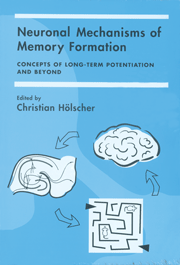Book contents
- Frontmatter
- Contents
- Contributors
- Introduction: Long-Term Potentiation as a Model for Memory Mechanisms: The Story So Far
- Section One Long-Term Potentiation In Vitro and In Vivo: How Can We Fine-Tune the Current Models for Memory Formation?
- Section Two There is More to the Picture Than Long-Term Potentiation: Theta or Gamma Oscillations in the Brain and the Facilitation of Synaptic Plasticity
- 5 Synaptic Potentiation by Natural Patterns of Activity in the Hippocampus: Implications for Memory Formation
- 6 Plasticity in Local Neuronal Circuits: In Vivo Evidence from Rat Hippocampus and Amygdala
- 7 Theta-Facilitated Induction of Long-Term Potentiation: A Better Model for Memory Formation?
- 8 Role of Gamma Oscillations for Information Processing and Memory Formation in the Neocortex
- Section Three Making Models from Empirical Data of Synaptic Plasticity
- Section Four Setting the Stage for Memory Formation: Stress, Arousal, and Attention
- Section Five Transgenic Mice as Tools to Unravel the Mechanisms of Memory Formation
- Conclusions and Future Targets
- Index
7 - Theta-Facilitated Induction of Long-Term Potentiation: A Better Model for Memory Formation?
Published online by Cambridge University Press: 13 October 2009
- Frontmatter
- Contents
- Contributors
- Introduction: Long-Term Potentiation as a Model for Memory Mechanisms: The Story So Far
- Section One Long-Term Potentiation In Vitro and In Vivo: How Can We Fine-Tune the Current Models for Memory Formation?
- Section Two There is More to the Picture Than Long-Term Potentiation: Theta or Gamma Oscillations in the Brain and the Facilitation of Synaptic Plasticity
- 5 Synaptic Potentiation by Natural Patterns of Activity in the Hippocampus: Implications for Memory Formation
- 6 Plasticity in Local Neuronal Circuits: In Vivo Evidence from Rat Hippocampus and Amygdala
- 7 Theta-Facilitated Induction of Long-Term Potentiation: A Better Model for Memory Formation?
- 8 Role of Gamma Oscillations for Information Processing and Memory Formation in the Neocortex
- Section Three Making Models from Empirical Data of Synaptic Plasticity
- Section Four Setting the Stage for Memory Formation: Stress, Arousal, and Attention
- Section Five Transgenic Mice as Tools to Unravel the Mechanisms of Memory Formation
- Conclusions and Future Targets
- Index
Summary
SUMMARY
As described in the introduction of this book, the induction of long-term potentiation (LTP) of synaptic transmission in the hippocampus using high frequency stimulation (HFS) cannot be seen as a physiologic method that models synaptic plasticity that might occur during learning. Several other stimulation protocols have been developed that emulate natural neuronal firing patterns more closely, and LTP obtained with such a technique may therefore provide a better model of learning-related plasticity. The novel stimulation protocol presented here makes use of the reduction of local inhibition during theta rhythm. This stimulation technique (five pulses at 200 Hz phase-locked with peaks of theta oscillations in vivo) is able to induce stable LTP with as few as fifteen stimuli. Such bursts of stimuli are comparable to natural activity that can be recorded in the living brain. This type of stimulation protocol appears to induce LTP in a different way than HFS does. The metabotropic glutamate receptor agonist 1S,3S-ACPD blocks HFS-induced LTP, but does not affect the ability of rats to learn spatial tasks. However, LTP induced by a stimulation protocol of short bursts that are given phase-locked with theta rhythm was not blocked by 1S,3SACPD. Hence, the novel stimulation protocol appears to induce LTP in a more physiologic way that correlates with learning abilities of rats. It is suggested that this protocol, which not only resembles natural firing patterns found in the hippocampus in a living brain, but also models changes in synaptic transmission that are linked to memory formation more closely than HFS-induced LTP, has the potential to be a better model for putative synaptic changes that occur during learning.
- Type
- Chapter
- Information
- Neuronal Mechanisms of Memory FormationConcepts of Long-term Potentiation and Beyond, pp. 146 - 166Publisher: Cambridge University PressPrint publication year: 2000



